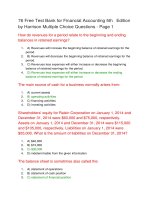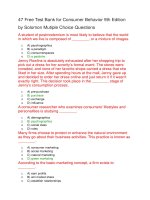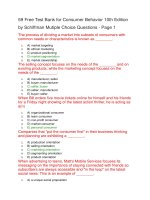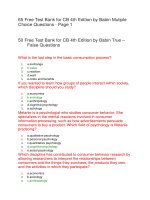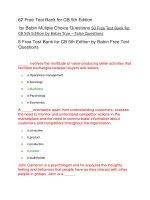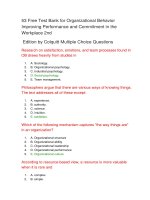144 free test bank for organizational behavior 5th
Bạn đang xem bản rút gọn của tài liệu. Xem và tải ngay bản đầy đủ của tài liệu tại đây (186.32 KB, 38 trang )
77 Free Test Bank for Organizational Behavior 5th
Edition by McShane Multiple Choice Questions - Page
1
56 Free Test Bank True – False Questions
11 Free Test Bank f Free Text Questions
Employees, suppliers and governments:
1.
A. are organizational stakeholders.
2.
B. are rarely considered in organizational behavior theories.
3.
C. represent the three levels of analysis in organizational behavior.
4.
D. are excluded from the open systems anchor.
5.
E. are all of the above.
In the field of organizational behavior, organizations are best
described as:
1.
A. legal entities that must abide by government regulations and pay taxes.
2.
B. physical structures with observable capital equipment.
3.
C. social entities with a publicly stated set of formal goals.
4.
D. groups of people who work interdependently towards some purpose.
5.
E. any social entity with profit-centered motives and objectives.
Intellectual capital refers to:
1.
A. how much money an organization spends on training and development.
2.
B. the stock knowledge that resides in an organization.
3.
C. the percentage of information available that is actually used productively
by the organization.
4.
D. the total cost of computers and other 'intelligent' machines in the
organization.
5.
E. the cost of hiring a typical employee.
______ refers to an organization's moral obligation toward all of
its stakeholders.
1.
A. Values
2.
B. Ethics
3.
C. Multicultural teams
4.
D. CSR
5.
E. OB
A computer maintenance company wants to 'capture' the
knowledge that employees carry around in their heads by creating
a database where employees document their solutions to unusual
maintenance problems. This practice tries to:
1.
A. transform intellectual capital into knowledge management.
2.
B. transfer human capital into structural capital.
3.
C. prevent relationship capital from interfering with human capital.
4.
D. reduce the amount of human capital.
5.
E. transfer structural capital into relationship capital.
_____ is the study of what people think, feel, and do in and
around organizations.
1.
A. OB
2.
B. Marketing
3.
C. Sociology
4.
D. Psychology
5.
E. Communication
Organizational behavior knowledge:
1.
2.
A. originates mainly from models developed in chemistry and other natural
sciences.
B. accurately predicts how anyone will behave in any situation.
3.
C. is more appropriate for people who work in computer science than in
marketing.
4.
D. helps us to understand, predict, and influence the behaviors of others in
organizational settings.
5.
E. does none of the above.
The perspective that effective organizations incorporate several
workplace practices that leverage the potential of human capital is
called
1.
A. HPWP.
2.
B. HPPW.
3.
C. LPHC.
4.
D. PHCL.
5.
E. none of the above.
Stakeholders include:
1.
A. shareholders.
2.
B. employees.
3.
C. suppliers.
4.
D. governments.
5.
E. all of the above.
The open systems anchor of organizational behavior states that:
1.
A. organizations affect and are affected by their external environments.
2.
B. organizations can operate efficiently by ignoring changes in the external
environment.
3.
C. people are the only important organizational input.
4.
D. organizations basically have only one working part.
5.
E. all of the above.
As part of the knowledge management process, experimentation
is conducive to:
1.
A. measuring intellectual capital.
2.
B. knowledge acquisition.
3.
C. organizational memory.
4.
D. knowledge sharing.
5.
E. unlearning.
Which of these statements about the field of organizational
behavior is FALSE?
1.
A. Organizational behavior scholars study individual, team and structural
characteristics that influence behavior within organizations.
2.
B. Given the specific utility of the field, OB is useful for the managers in the
organizations and not the employees.
3.
C. Organizational behavior emerged as a distinct field around the 1940s.
4.
D. The field of OB has adopted concepts and theories from other fields of
inquiry.
5.
E. OB scholars study what people think, feel and do in and around
organizations.
Which of the following typically results in a loss of intellectual
capital?
1.
2.
A. The processes used to make a unique product are incorrectly
documented.
B. The company lays off nearly one-quarter of its workforce.
3.
C. The company sells one of its divisions and those employees now work
for the other organization.
4.
D. All of the above.
5.
E. None of the above.
Companies 'manage' knowledge by:
1.
2.
3.
A. extracting information and ideas from the external environment and
through experimentation.
B. ensuring that knowledge is shared throughout the organization.
C. ensuring that employees effectively use the knowledge available to
them.
4.
D. all of the above.
5.
E. doing only 'B' and 'C'.
Intellectual capital consists of:
1.
A. knowledge that employees possess and generate.
2.
B. the knowledge captured in an organization's systems and structures.
3.
C. the value that customers provide to the organization.
4.
D. all of the above.
5.
E. 'A' and 'B' only.
From the open systems view of the organizations, which of these
is NOT an input?
1.
A. Human resources
2.
B. Raw materials
3.
C. Equipment
4.
D. Information
5.
E. Profits
Which of the following relates to the idea that organizations are
open systems?
1.
A. The organization adjusts its services to satisfy changing consumer
demand.
2.
B. The organization finds a substitute resource in anticipation of a future
shortage of the resource previously used to manufacture the product.
3.
C. Production and sales employees coordinate their work activities to
provide a more efficient work process.
4.
D. The organization changes its products to suit customer needs.
5.
E. All of the above.
Twice each year, a major car parts manufacturer brings together
production and engineering specialists from its eight divisions to
discuss ideas, solutions, and concerns. This helps to minimize the
'silos of knowledge' problem that exists in many organizations.
This practice is primarily an example of:
1.
A. grafting.
2.
B. experimentation.
3.
C. knowledge sharing.
4.
D. documentation.
5.
E. organizational unlearning.
According to the authors of your text, organizational behavior
knowledge:
1.
A. should never be used to influence the behavior of other people.
2.
B. should be used mostly by managers and senior executives.
3.
C. should never replace your commonsense knowledge about how
organizations work.
4.
D. is relevant to everyone who works in organizations.
5.
E. both 'A' and 'B'.
Organizations retain intellectual capital by:
1.
A. transferring employee capital into structural capital.
2.
B. encouraging employees to take early retirement.
3.
C. discouraging employees from communicating with each other.
4.
D. all of the above.
5.
E. none of the above.
Which of the following is a form of knowledge acquisition?
1.
A. Grafting
2.
B. Experimentation
3.
C. Information sessions where employees describe to colleagues unique
incidents involving customers
4.
D. All of the above
5.
E. 'A' and 'B' only
The triple bottom line philosophy says that:
1.
A. companies should pay three times as much attention to profits than to
employee wellbeing.
2.
B. the main goal of all companies is to satisfy the needs of three groups:
employees, shareholders, and suppliers.
3.
C. business success increases by having three times more contingent
workers than permanent employees.
4.
5.
D. companies should pay attention to local, national, and global customers.
E. companies should try to support the economic, social, and
environmental spheres of sustainability.
Which organizational behavior perspective discusses inputs,
outputs, and feedback?
1.
A. Contingency
2.
B. Open systems
3.
C. Multidisciplinary
4.
D. Systematic research
5.
E. None of the above
Which of the following statements about the field of organizational
behavior is FALSE?
1.
A. OB is the study of what people think, feel and do in and around
organizations.
2.
B. OB emerged as a distinct field of inquiry in the 1940s.
3.
C. OB is a self-contained discipline, independent of other disciplines.
4.
D. OB theories are usually tested using the scientific method.
5.
E. Many OB theories are contingency-oriented.
Knowledge management is an extension of:
1.
A. traditional accounting methods of measuring corporate assets.
2.
B. the open systems perspective of organizational behavior.
3.
C. microeconomic principles of supply and demand.
4.
D. the efficiency model of industrial engineering.
5.
E. none of the above.
Stable, long-lasting beliefs about what is important in a variety of
situations are:
1.
A. called intellectual capital.
2.
B. the foundations of the open systems anchor.
3.
C. the main reason why virtual teams fail.
4.
D. rarely studied in the field of organizational behavior.
5.
E. called values.
Which of these describes groups of people who work
interdependently towards some purpose?
1.
A. OB
2.
B. Globalization
3.
C. Work/Life balance
4.
D. Knowledge management
5.
E. Organizations
Organizational behavior views organizations as:
1.
A. non-systems.
2.
B. a single unitary subsystem.
3.
C. open systems.
4.
D. closed systems.
5.
E. none of the above.
Intellectual capital is:
1.
A. the total terabytes of hard disk space available on computers throughout
an organization.
2.
B. the ability of senior executives to recall important information about the
company's products, services and employees.
3.
C. the company's stock of knowledge.
4.
D. the ability of employees throughout the organization to recall important
information about the company's products and services.
5.
E. the extent to which potential customers are able to recall specific
products and services provided by an organization.
Which of these refers to the perspective that companies take their
sustenance from the environment and, in turn, affect that
environment through their outputs?
1.
A. Contingency anchor
2.
B. Systematic research
3.
C. Closed system
4.
D. CSR
5.
E. Open system
ACME Software Inc. has developed a training program to make
employees more aware of how their job performance affects
customers and other employees within the organization. This
training program relates most closely with which of the following
concepts?
1.
A. Contingency anchor
2.
B. Grounded theory
3.
C. Open systems
4.
D. Virtual teams
5.
E. Telecommuting
Eastern University performs a daily computer search through
newspaper articles to identify any articles about the university or
its faculty members. University administrators use this information
to receive feedback about how the public reacts to university
activities. In knowledge management, searching for newspaper
articles and other external writing about the organization is mainly
a form of:
1.
A. knowledge acquisition.
2.
B. grafting.
3.
C. organizational unlearning.
4.
D. knowledge sharing.
5.
E. documentation.
Which of these statements about the field of organizational
behavior is TRUE?
1.
2.
A. Organizational behavior emerged as a distinct field during the 1940s.
B. The origins of some organizational behavior concepts date back to
Taylor and Mayo.
3.
C. Information technology has almost no effect on organizational behavior.
4.
D. The field of organizational behavior relies exclusively on ideas generated
within the field by organizational behavior scholars.
5.
E. The origins of organizational behavior are traced mainly to the field of
economics.
Which of the following statements is a proposition of highperformance work practices?
1.
A. Employees are an important source of competitive advantage.
2.
B. Human capital is rare.
3.
4.
5.
C. The value of human capital can be increased through specific
organizational practices.
D. Organizational practices have a synergistic effect.
E. All of the above statements about high-performance work practices are
true.
The topic of ethics is most closely associated with:
1.
A. values.
2.
B. the scientific method.
3.
C. workforce diversity.
4.
D. the open systems anchor.
5.
E. the contingency approach to organizational behavior.
______ refers to the study of moral principles or values that
determine whether actions are right or wrong and outcomes are
good or bad.
1.
A. Values
2.
B. Ethics
3.
C. Multicultural teams
4.
D. CSR
5.
E. OB
Corporate social responsibility is most closely related to which of
these organizational behavior trends?
1.
A. Workforce diversity
2.
B. Employment relationships
3.
C. Information technology
4.
D. Globalization
5.
E. Workplace values and ethics
77 Free Test Bank for Organizational Behavior 5th
Edition by McShane Multiple Choice Questions - Page
2
Which of these statements about globalization and organizational
behavior is TRUE?
1.
A. Globalization has little or no effect on organizational behavior.
2.
B. Globalization has forced organizational behavior researchers to study
only large multinational businesses.
3.
C. Globalization gives rise to the question of how corporate leaders and
employees can work effectively in the global workplace.
4.
D. Globalization has forced organizational behavior textbooks to study only
companies with headquarters in North America.
5.
E. Both 'B' and 'D' are true.
Which of the following concepts are closely associated with
corporate social responsibility?
1.
A. Knowledge management
2.
B. Triple bottom line
3.
C. Stakeholders
4.
D. All of the above
5.
E. Both 'B' and 'C'
Allison thinks that organization is the same as an organism.
However, in the field of organizational behavior, organizations are
best described as:
1.
A. legal entities that must abide by government regulations and pay taxes.
2.
B. physical structures with observable capital equipment.
3.
C. social entities with a publicly stated set of formal goals.
4.
D. groups of people who work interdependently towards some purpose.
5.
E. any social entity with profit-centered motives and objectives.
Employee behaviors that extend beyond normal job duties:
1.
A. should be discouraged by organizational leaders.
2.
B. are usually performed by people with low conscientiousness.
3.
C. are the most important characteristics of people with an external locus of
control.
4.
D. are common in small businesses but never occur in large firms.
5.
E. are called organizational citizenship behaviors.
Which of the following statements is FALSE?
1.
A. Employment relationships are shifting towards the idea that companies
must provide employees a high degree of job security, possibly even a job
for life.
2.
B. Generation-X employees bring somewhat different values and needs to
the workplace than those of baby boomers.
3.
C. The workforce is becoming more diverse.
4.
D. Successful firms increasingly rely on values alignment rather than direct
supervision to guide employee decisions and behavior.
5.
E. Information technologies are changing the way people perform their
tasks and work with each other.
Workforce diversity:
1.
2.
A. includes the entry of younger people to the workforce.
B. can potentially improve decision making and team performance in
organizations.
3.
C. is increasing in the United States.
4.
D. includes the increasing proportion of Hispanics in the workforce.
5.
E. all of the above.
Sabotage, threatening harm, and insulting others represent:
1.
A. three forms of counterproductive work behaviors.
2.
B. the most common forms of organizational citizenship.
3.
C. three dimensions of Schwartz's values model.
4.
D. evidence of people with an introverted personality.
5.
E. behaviors that are no longer found in organizations.
Your roommate, Allison Albright, is a non-business major. When
she discovered that you are taking a course in Organizational
Behavior, she was thoroughly confused as to why one would
need to study OB and what it entails. You are trying to explain
Allison about the basic conceptual anchors that guide the thinking
about organizations and how to study them. She asks you some
clarification questions. Which of the following is NOT a conceptual
anchor in organizational behavior?
1.
A. Contingency anchor
2.
B. Systematic research
3.
C. Organizational effectiveness anchor
4.
D. Multidisciplinary anchor
5.
E. Multiple levels of analysis anchor
Your roommate, Allison Albright, is a non-business major. When
she discovered that you are taking a course in Organizational
Behavior, she was thoroughly confused as to why one would
need to study OB and what it entails. You are trying to explain
Allison about the basic conceptual anchors that guide the thinking
about organizations and how to study them. She asks you some
clarification questions. All of the following are conceptual anchors
in organizational behavior EXCEPT:
1.
A. Contingency anchor.
2.
B. Systematic research anchor.
3.
C. Multidisciplinary anchor.
4.
D. Societal level anchor.
5.
E. Multiple levels of analysis anchor.
If Dave's employees quit their jobs, according to research, the
main reason why they quit their jobs may be that:
1.
A. they lack the ability to stay employed.
2.
B. they are dissatisfied with the job or work context.
3.
C. other firms use powerful incentives to lure employees from their current
jobs.
4.
D. they see their co-workers being laid off, so they also want to leave.
5.
E. they have the wrong attitude about loyalty to one employer.
Which discipline has provided organizational behavior with much
of its theoretical foundation for team dynamics, organizational
power, and organizational socialization?
1.
A. Sociology
2.
B. Psychology
3.
C. Economics
4.
D. Industrial engineering
5.
E. Political science
Which of the following would be considered a work-related
behavior?
1.
A. Completing required job duties
2.
B. Showing up for work at scheduled times
3.
C. Accepting the organization's offer of employment
4.
D. Helping a co-worker even though it isn't part of your job
5.
E. All of the above.
Which of these statements is consistent with the five anchors of
organizational behavior?
1.
A. Organizational behavior theories must apply universally to every
situation.
2.
B. Organizations are like machines that operate independently of their
external environment.
3.
4.
5.
C. Each OB topic relates to only one level of analysis.
D. The field of organizational behavior should rely on other disciplines for
some of its theory development.
E. None of these statements is consistent with the OB anchors.
__________ refers to goal-directed behaviors under the
individual's control that support organizational objectives.
1.
A. Strategic performance
2.
B. Task performance
3.
C. Tactical performance
4.
D. Contextual performance
5.
E. Organizational performance
Globalization occurs when an organization:
1.
A. increases its connectivity with people and organizations in other parts of
the world.
2.
B. serves diverse customers within the firm's home country.
3.
C. has a diverse workforce within the firm's home country.
4.
D. does all of the above.
5.
E. does only 'B' and 'C'.
If Bob wants to consider deep-level diversity he would
1.
2.
A. review the demographic characteristics of his workforce.
B. consider the likelihood of long-term employment with the organization for
each of his employees.
3.
C. observe the differences in the people who represent his workforce.
4.
D. look at different attitudes and expectations of his employees.
5.
E. both 'C' and 'D'.
According to the multiple levels of analysis anchor:
1.
A. organizational behavior is mainly the study of how all levels of the
organizational hierarchy interact with the external environment.
2.
B. OB topics typically relate to the individual, team and organizational levels
of analysis.
3.
C. there are eight levels of analysis that scholars should recognize when
conducting OB research.
4.
D. organizational events can be studied from only one level of analysis.
5.
E. corporate executives need to understand business ethics from various
levels and perspectives.
Bob has been interested in this trend of globalization. He should
know that globalization occurs when an organization:
1.
A. increases its connectivity with people and organizations in other parts of
the world.
2.
B. serves diverse customers within the firm's home country.
3.
C. has a diverse workforce within the firm's home country.
4.
D. does all of the above.
5.
E. does only 'B' and 'C'.
To help Allison understand some preliminary information about
OB, which of these statements about the field is FALSE?
1.
A. Organizational behavior scholars study individual, team and structural
characteristics that influence behavior within organizations.
2.
B. The field of OB has adopted concepts and theories from other fields of
inquiry.
3.
C. Organizational behavior emerged as a distinct field around the 1940s.
4.
D. Given the specific utility of the field, OB is useful for the managers in the
organizations and not the employees.
5.
E. OB scholars study what people think, feel, and do in and around
organizations.
Which of the following is an example of an organizational
citizenship behavior?
1.
A. tardiness
2.
B. doing work incorrectly
3.
C. cooperation toward the organization
4.
D. following state and federal corporate laws
5.
E. developing a corporation strategic plan
Bob has never liked the idea of telecommuting for employees of
Tricky Toys. According to research, telecommuting offers all of
these benefits EXCEPT:
1.
A. reduced employee stress.
2.
B. enhanced employee recognition.
3.
C. improved job satisfaction.
4.
D. making employees feel more empowered.
5.
E. reduced pollution.
According to research, telecommuting offers all of these benefits
EXCEPT:
1.
A. reduce employee stress.
2.
B. increase employee productivity.
3.
C. improve job satisfaction.
4.
D. make employees feel more empowered.
5.
E. enhance employee recognition.
Which of the following is considered a counterproductive work
behavior?
1.
A. Insulting others
2.
B. Theft
3.
C. Deliberating performing work incorrectly so the organization suffers a
loss
4.
D. All of the above
5.
E. Only 'B' and 'C'
Generous sick leave policies are known to:
1.
A. increase employee lateness.
2.
B. improve organizational citizenship.
3.
C. increase absenteeism.
4.
D. increase voluntary turnover.
5.
E. both 'C' and 'D'.
In collecting his information on OB trends, Bob should be told that
all of these statements about America's population and workforce
are true EXCEPT which one?
1.
2.
3.
4.
5.
A. Within the next decade, Asian-Americans will replace African-Americans
as the second largest ethnic group.
B. Surface-level diversity has increased over the past few decades.
C. Generation-X employees bring somewhat different needs and
expectations to the workplace than their baby-boomer counterparts.
D. The United States is becoming a more multicultural society.
E. Workforce diversity presents both opportunities and challenges to
organizations.
Your roommate, Allison Albright, is a non-business major. When
she discovered that you are taking a course in Organizational
Behavior, she was thoroughly confused as to why one would
need to study OB and what it entails. You are trying to explain
Allison about the basic conceptual anchors that guide the thinking
about organizations and how to study them. She asks you some
clarification questions.Which of these statements is consistent
with the four anchors of organizational behavior?
1.
A. Organizational behavior theories must apply universally to every
situation.
2.
B. Organizations are like machines that operate independently of their
external environment.
3.
4.
5.
C. Each OB topic relates to only one level of analysis.
D. The field of organizational behavior should rely on other disciplines for
some of its theory development.
E. None of these statements is consistent with the OB anchors.
Which of the following is NOT a work-related behavior?
1.
A. Competencies
2.
B. Absenteeism
3.
C. Joining the organization
4.
D. Showing up for work at scheduled times
5.
E. Performing required tasks
Your roommate, Allison Albright, is a non-business major. When
she discovered that you are taking a course in Organizational
Behavior, she was thoroughly confused as to why one would
need to study OB and what it entails. You are trying to explain
Allison about the basic conceptual anchors that guide the thinking
about organizations and how to study them. She asks you some
clarification questions. Which of the following does NOT represent
a belief that anchors organizational behavior?
1.
2.
3.
4.
5.
A. OB should view organizations as closed systems.
B. OB should assume that the effectiveness of an action usually depends
on the situation.
C. OB should draw on knowledge from other disciplines.
D. OB should rely on the systematic research methods to generate
knowledge.
E. OB topics can be studied from multiple levels of analysis.
Which of these represent the one-third of the American
population?
1.
A. Asian Americans
2.
B. Chinese
3.
C. American Indians
4.
D. African Americans
5.
E. Hispanics
Which of the following statements about America's population and
workforce is FALSE?
1.
A. Within the next decade, Asian-Americans will replace African-Americans
as the second largest ethnic group.
2.
B. The participation of women in the workforce has increased over the past
few decades.
3.
C. Generation-X employees bring somewhat different needs and
expectations to the workplace than their baby-boomer counterparts.
4.
5.
D. The United States is becoming a more multicultural society.
E. Workforce diversity presents both opportunities and challenges to
organizations.
Which of the following is NOT a conceptual anchor in
organizational behavior?
1.
A. Contingency anchor
2.
B. Systematic research anchor
3.
C. Economic anchor
4.
D. Multidisciplinary anchor
5.
E. Multiple levels of analysis anchor
_______ refers to economic, social, and cultural connectivity with
people in other parts of the world.
1.
A. OB
2.
B. Globalization
3.
C. Work/Life balance
4.
D. Knowledge management
5.
E. The changing workforce
To collect and analyze information systematically, organizational
behavior researchers rely on:
1.
A. forming research questions, collecting data, and testing hypotheses.
2.
B. closed systems theory.
3.
C. systematic research.
4.
D. all of the above.
5.
E. both 'A' and 'C'.
Organizational citizenship refers to:
1.
A. the employee's right to vote for the company president.
2.
B. employee behaviors that extend beyond normal job duties.
3.
C. the organization's obligations to society.
4.
5.
D. the organization's attachment to a particular country rather than being a
global entity.
E. both 'C' and 'D'.
Which of the following does NOT represent a belief that anchors
organizational behavior?
1.
2.
3.
4.
5.
A. OB should view organizations as closed systems.
B. OB should assume that the effectiveness of an action usually depends
on the situation.
C. OB should draw on knowledge from other disciplines.
D. OB should rely on the systematic research methods to generate
knowledge.
E. OB topics can be studied from multiple levels of analysis.
Showing up late to work or not showing up at all represent:
1.
A. forms of counterproductive work behaviors.
2.
B. the most common forms of organizational citizenship.
3.
C. dimensions of Schwartz's values model.
4.
D. evidence of people with an introverted personality.
5.
E. behaviors those are acceptable in organizations under new employability
concept.
Allison needs to know that according to the authors of the text,
organizational behavior knowledge:
1.
A. should never be used to influence the behavior of other people.
2.
B. should be used mostly by managers and senior executives.
3.
C. should never replace your commonsense knowledge about how
organizations work.
4.
D. is relevant to everyone who works in organizations.
5.
E. both 'A' and 'B'.
The contingency anchor of organizational behavior states that:
1.
A. we should have a second OB theory to explain the situation in case our
first choice doesn't work.
2.
B. OB theories must view organizations as systems that need to adapt to
their environments.
3.
4.
5.
C. there is usually one best way to resolve organizational problems.
D. a particular action may have different consequences in different
situations.
E. all of the above.
Which of the following refers to goal-directed activities under the
individual's control that support organizational objectives?
1.
A. Competencies
2.
B. Task performance
3.
C. Aptitudes
4.
D. Direction
5.
E. Motivation
Your roommate, Allison Albright, is a non-business major. When
she discovered that you are taking a course in Organizational
Behavior, she was thoroughly confused as to why one would
need to study OB and what it entails. You are trying to explain
Allison about the basic conceptual anchors that guide the thinking
about organizations and how to study them. She asks you some
clarification questions. To collect and analyze information
systematically, organizational behavior researchers rely on:
1.
A. forming research questions, systematically collecting data, and testing
hypotheses.
2.
B. closed systems theory.
3.
C. standards of systematic research.
4.
D. all of the above.
5.
E. both 'A' and 'C'.
56 Free Test Bank for Organizational Behavior 5th
Edition by McShane True - False Questions - Page 1
The open systems perspective emphasizes that organizations
survive by adapting to changes in the external environment.
1.
True
2.
False
Ethics refers to the study of moral principles or values that
determine whether actions are right or wrong and outcomes are
good or bad.
1.
True
2.
False
Open system organizations are unable to maintain a close
alignment of the organization's systems with the external
environment.
1.
True
2.
False

